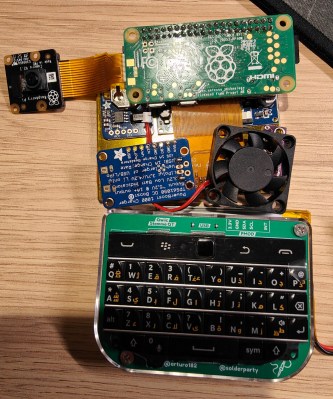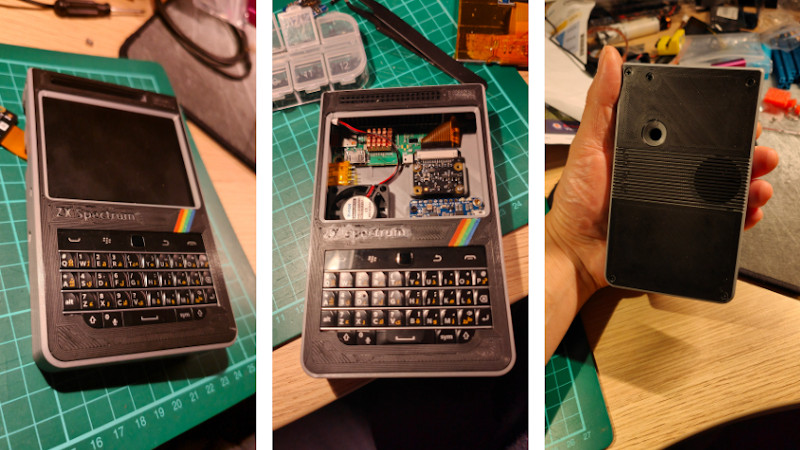Let’s face it — Android wasn’t what most of us had in mind when we imagined having Linux running on our phones. While there’s a (relatively) familiar kernel hiding at the core of Google’s mobile operating system, the rest of the environment is alien enough that you can’t run Linux software on it without jumping through some hoops. While that’s fine for most folks, there remains a sizable group of users who still dream of a mobile device that can run a full Linux operating system without any compromises.
 Judging by the work put into the Blackberry Pi, we’re willing to bet that [IMBalENce] falls into that camp. The custom handheld combines the Raspberry Pi Zero, a 320×240 LCD, and the BBQ20KBD keyboard from Solder Party with a 2500 mAh LiPo pouch cell and associated charging circuitry. Optionally, it also supports modules such as the Raspberry Pi Camera, a Real-Time-Clock, a ADS1015 ADC to read the battery voltage, and even a USB hub — although you can’t have all the goodies installed at once as it draws too much current.
Judging by the work put into the Blackberry Pi, we’re willing to bet that [IMBalENce] falls into that camp. The custom handheld combines the Raspberry Pi Zero, a 320×240 LCD, and the BBQ20KBD keyboard from Solder Party with a 2500 mAh LiPo pouch cell and associated charging circuitry. Optionally, it also supports modules such as the Raspberry Pi Camera, a Real-Time-Clock, a ADS1015 ADC to read the battery voltage, and even a USB hub — although you can’t have all the goodies installed at once as it draws too much current.
Everything is packed into a 3D printed case that looks roughly like an original DMG-01 Game Boy if somebody replaced the bottom half with a tiny keyboard. We appreciate the ZX Spectrum theme, even if it’s not immediately clear how it relates to the project other than being an excuse to play around with multi-color printing. [IMBalENce] says the final product works quite well, though the relatively limited keys on the BlackBerry keyboard does make it tricky to use the device for writing code.
Interested in mobile Linux, but not trying to build the hardware yourself? We recently took a look at the SQFMI Beepy, which is fairly similar in terms of hardware, but very much in need of some talented penguin wranglers who are willing to come in and work on the software and documentation. Think you’re up for the challenge?

















Let’s face it, Raspberry Pi wasn’t what most of us want when we talk about SBC: overpriced, outdated hardware with low performance/watt.
Outperformed by any metric in their own ARM SBC, make no sense to use it in any new project.
Cheap RISC-V SBC already in high use in industrial setting.
Why we keep using it?
Beside point “traditional” SBC became too expensive and inflexible (with quote like +$100 just for 8GB of ram), maybe we in need of new open standard: cheap, highly modular and space efficient.
You should start an open source RISC-V SBC company!
Most? … Guess I am not one of ‘most’ :) . I like the RPI family. I just picked up two RPI-4 4GB at normal pricing $55 and free shipping. Have a couple projects in the wings for them. Finally seeing the boards show up in stock at the ‘normal’ retailers (will not pay scalper prices) I frequent.
Neat project above. I wish all phones had a keypad just like the old ones did. I dislike typing on virtual keyboards.
Nope…it’s $100 for 8GB (8GB is almost double the price of a 4GB model). Here is South Africa as well. One of our large electronic component shops just got their first Raspberry stock after covid, and it works out to just over $100 for an 8GB Rpi4 (and they are the cheap ones – as for the scalpers?…you know the answer).
Are you not using USD? Or are you maybe looking at a kit with extra stuff? The Pi 4B 8GB is 75USD on its own from any approved reseller, and the models with less memory are cheaper – 35USD for the 1GB model.
The bigger problem is they’re never in stock!
Here in the US, Adafruit, Sparkfun, pi shop. All $75. Personally I just want the 1GB at $35 as that is still ‘swimming’ in memory for my use.
Should have added … but the 4GB was in stock, so just got a couple of them instead of the 1GB model. I don’t need the 8GB model for any of my projects, although I do have one. Right now they all run ‘head-less’.
Same here. The Pi1 and 2 still works for me. I have never had a need to use a Pi as any kind of desktop computer (and even then, building your own Linux you can squeeze kernel, X11, and a window manager in, in under 100MB), so 1GB is already way too much for my uses.
I just replaced two of my RPI Zero Ws with a couple of Pico W boards. Really liking the cheap RP2040 boards now for a lot of the little projects. No need for the overhead of Linux just to read a few inputs, a little glue logic, and click a few relays :) . We sure are living in a golden age for electronic hobbyists.
The RPI 4s are destined for two Freenove robot projects, the dog (building now) and the hex-a-pod as that is the recommended platform.
Hey that is right on !! Can we convince RIM to resurrect the best portable phone ever designed/produced to relieve the eorld of that Apple monstrosity?
John
Raspberry pi is awful the hardware is outdated over priced and the company behind it hired a cop who they paraded about as being an expert in surveillance equipment blocked everyone on social media that called them out for it and made deals to sell their product in bulk to make mass produced junk with lazy engineers rather than selling them to the makers and hobiests who made them successful in the first place during the pandemic and chip shortage
Fifteen bucks is too much? (This is an honest question. Is it too much?)
Don’t people already have phones a lot more powerful than this?
Imagine not even reading the first sentence before rushing down here to leave a worthless comment….
Good luck running natively on them anything but their stock, dumbed down, spyware ridden, insecure, closed, proprietary, toy operating system.
No, Android is not Linux. Not even close.
Use Ubuntu Touch phone, you will have full Linux distro.
I feel such want for this, but also pretty much hate typing on a phone, and that’s just for normal text.. moving around in code or special characters is horrible.
And I also shun even laptop keyboards so, I should probably not get/make one… But I do want to.
It’s actually not too bad. After a week of use, I’m starting to get used to touch typing on the keypad.
I am a huge pico fan, 2$ and you get dual core 133mhh and all that GPIO/SPI/UART/IC@ and etc – its a very powerful device in the right hands.
For similar price you can have ESP32.
Why the hell would you want ESP32 when Pico with Wifi/Bluetooth completely blows it out of water in energy consumption, not having obscure architecture, closed chinese firmware, much better tooling like dirty cheap debuggers etc..
Wow! Never thought my make could get introduced on Hackaday. Thank you for the nice article, Tom.
In response to some comments, I hope to clarify that the purpose of the build is to enable easier testing of hardware, such as sensors, motors, etc, with interactive feedback on the screen. That’s why the GPIO pins are directly accessible through the front panel. And with the brass screw inserts on the side of enclosure, it is much easier to mount more accessories in the future (already planning to add my spare pi sensor hat to the to top).
I guess raspberry pi would never be the first choice if performance or price is the priority. But for many tinkerers like myself who have limited understanding about Linux, well documented Pi is much easier to start with, especially for projects that need to interact with real life world. At some stage, I might summarize a bit more about my rEMote Pi project that use a Pi to remote control a super resolution electron microscope.
https://twitter.com/IMBalENce/status/1537397686890278912?t=THPhD4qqlBJmJOhTJ5kfLw&s=09
A quick update: with the help from SQFMI Beepy discord friends, I was able to get the BBQ20kbd I2C driver working (https://github.com/wallComputer/bbqX0kbd_driver), which allow me to remap the function of keys.
Have we all forgotten about Sailfish ( https://sailfishos.org/ ) ? :)
And what about it? 🙄
Literally the first sentence in the article says people dream of having a full Linux phone rather than Android. I’ve had one for many years in the form of Maemo, and later, Sailfish. There’s no need to dream – you buy a supported modern device, buy a Sailfish license, unlock the bootloader and install it, and bingo, you have a full Linux phone in your pocket.
Don’t forget Pocket C.H.I.P
https://hackaday.com/2017/09/08/pocketchip-as-a-hardware-hackers-terminal/
and cutiepi
Pinephone with keyboard attachment tried, but is still kind of struggling
Pinephone has a fatal flaw: it uses a phone chipset that includes its own 32 bit processor, but that is used as a black box phone module while ANOTHER processor is used to run Linux. This results in ridiculous power consumption. I bought one a couple years ago, when you couldn’t even get a system image that would boot, and then tried again over the Summer, to find that there are multiple viable OSs, some of which work, but none of which are optimized for low-power mobile use. You might be able to use it as a computer, but as a phone it is completely impractical. Won’t even run overnight, idling with the screen turned off.
Interesting…
As this Motorola Edge I “bought” last Spring is a lousy excuse for a cell phone, I’ve been considering what it would be like to have a PinePhone.
It seems like every week, there’s a new mini linux gizmo in the blackberry or flip phone form factor. If this one had higher resolution screen it would be near the top of my list :-)
Keep on hacking, guys and girls! You’re getting closer and closer to my dream device… not to mention maybe one of the big manufacturers will realise there’s a market for an open device running proper Linux and a real keyboard.
I guess there may be some actual demand for this form factor, then. I mean, if people go to the trouble to build something themselves because what they want isn’t commercially available, that says something. But then, there are also a number of 80s-style computers and computer kits available, which doesn’t mean you could sell one of those in the mass market.